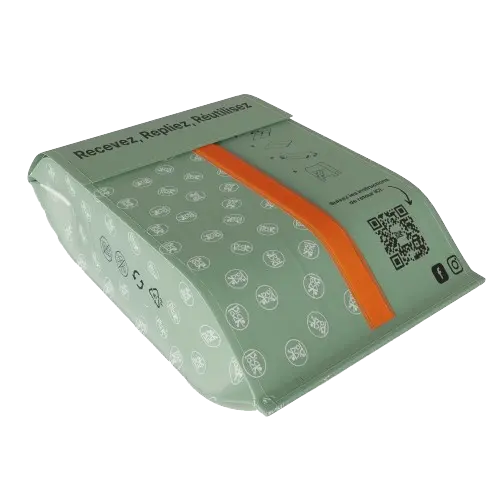When venturing outdoors with your little ones for activities like hiking, skiing, running or just going for a stroll in a stroller, it's essential to stay warm, dry and comfortable! The multi-layer system, also known as “layering”, is a technique that really makes all the difference.
This approach consists of layering different layers of clothing to allow you to regulate body temperature depending on external conditions and the type of activity... These are the famous onion skins as our grandmothers used to say!
In this article, we will explore the techniques and materials to favor for effective layering!
Layering is based on three distinct layers, each having a specific role to play:

The base layer (or base layer)
The base layer should be in direct contact with the skin. Its role is to regulate humidity by wicking sweat or moisture away from the body to keep it dry.
You should definitely avoid cotton as a base layer, as it tends to retain moisture, which can make you cold quickly.
Merino wool is a perfect base layer because it expels moisture and acts as a thermoregulating insulator. Our scalable wetsuits as well as our scalable thermal sets are the base layers of choice!

The intermediate layer (or midlayer)
This layer retains body heat by trapping warm air. Common insulation materials include merino wool, polyester, sherpa, and fleece. These fabrics are light, breathable and provide excellent thermal insulation. Depending on the weather, you can opt for thicker or thinner mid layers.
Our fleece sets, sherpa jumpsuit, colorblock sweaters, and even merino sweat sets are great mid-layers. Note that they can also be worn directly on the skin as well.
The outer layer (or shell)
The outer layer protects against external elements, such as rain, wind and snow.
Waterproof, breathable, and wind-resistant jackets and pants are great options for staying dry and warm.

Choose the right materials
Material selection is crucial for effective layering . Here are some options for each layer:
- Base Layer : Choose technical fabrics such as merino wool, polyester or synthetic fiber blends. These materials wick sweat away from the skin, dry quickly and maintain their insulating capacity even when damp. Avoid cotton at all costs… including stockings !
- Mid Layer : Merino wool is a great choice, as it provides exceptional warmth and optimal breathability. Fleeces and synthetic materials are also recommended for their ability to retain heat while wicking away moisture.
- Outer Layer : Look for waterproof and breathable materials such as GORE-TEX or eVent. These fabrics keep water out while allowing excess heat and moisture to escape. Generally, children's snowsuits are made of waterproof materials, allowing them to play outside comfortably!
Practical tips for effective layering
- Make sure the layers fit well to avoid cold air spots and promote mobility.
- A merino wool balaclava under a beanie is an interesting option to protect the neck, nape and cheeks from the cold.
- It's a good idea to wear merino wool under regular mittens to manage moisture and avoid cold hands.
- The same goes for stockings! To avoid cold feet, you should avoid cotton stockings. Merino wool socks look great in winter boots.

Examples of overlays
These layering examples are general suggestions. It is important to adjust based on individual preferences, activity level and weather variations.
The objective is to allow easy adaptation to temperature changes while ensuring the child's comfort.
| Weather conditions | Wool weight | Example of layering |
| Hot (15 to + 20°C) | Light ( 150-200 g/m²) | Merino wool base layer ( suit or thermal set ) |
| Temperate (10-15°C) | Lightweight (150-200 g/m²) | Merino wool base layer ( suit or thermal set ) with an outer layer like a mid-season coat or a lightweight mid-layer if necessary like our sherpa suit. |
| Cool (5-10°C) | Light to medium (150-250 g/m²) | Merino wool base layer ( suit or thermal set ) with an outer layer such as a mid-season coat or mid-layer or our sherpa suit . |
| Cold (0-5°C) | Medium (200-250 g/m²) | Merino wool base layer ( suit or thermal set ) with an outer layer like a mid-season coat. Or you could opt for a mid-layer like our fleece set or sherpa onesie with a lightweight outer layer like a windbreaker. |
| Very Cold (-5 to -10°C) | Medium to thick (200 to 360 g/m²) | Merino wool base layer ( suit or thermal set ) and a middle layer like our fleece set or our sherpa suit with an outer layer on top. |
| Extremely Cold (-10 to -20°C) | Medium to thick (200 to 400 g/m²) | Merino wool base layer ( suit or thermal set ) plus an insulating middle layer like our fleece set or our sherpa suit with an outer layer on top like a snowsuit. |
The multi-layer system is an essential technique for staying comfortable during your outdoor activities and playing outside with little ones without compromising their comfort.
By avoiding cotton as a base layer and choosing suitable technical materials, you will be able to effectively regulate body temperature, stay dry and fully enjoy your outdoor adventures, whatever the weather conditions!
This is how you and your little adventurers will be able to appreciate all that nature has to offer while creating magnificent memories!




